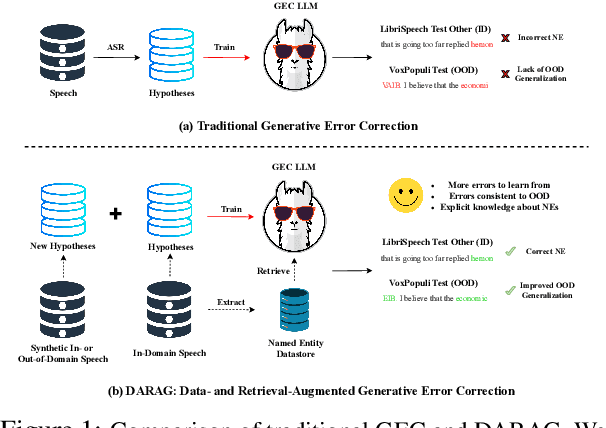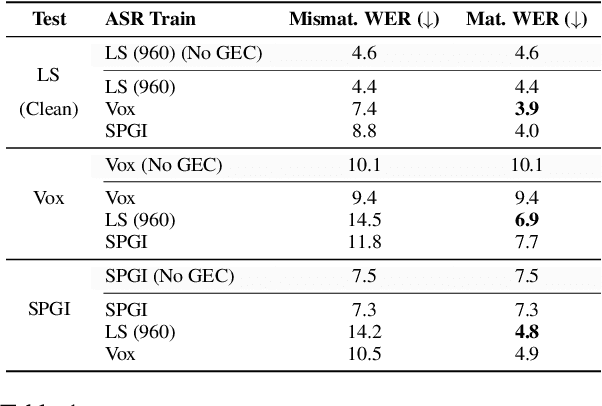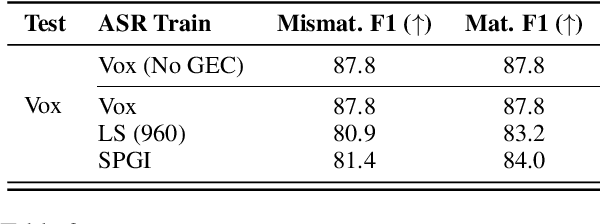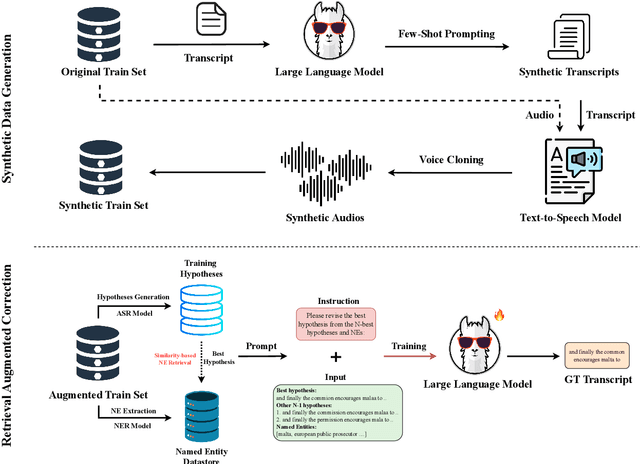Jian Xue
Generative AI for Analysts
Dec 12, 2025Abstract:We study how generative artificial intelligence (AI) transforms the work of financial analysts. Using the 2023 launch of FactSet's AI platform as a natural experiment, we find that adoption produces markedly richer and more comprehensive reports -- featuring 40% more distinct information sources, 34% broader topical coverage, and 25% greater use of advanced analytical methods -- while also improving timeliness. However, forecast errors rise by 59% as AI-assisted reports convey a more balanced mix of positive and negative information that is harder to synthesize, particularly for analysts facing heavier cognitive demands. Placebo tests using other data vendors confirm that these effects are unique to FactSet's AI integration. Overall, our findings reveal both the productivity gains and cognitive limits of generative AI in financial information production.
PHRASED: Phrase Dictionary Biasing for Speech Translation
Jun 10, 2025Abstract:Phrases are essential to understand the core concepts in conversations. However, due to their rare occurrence in training data, correct translation of phrases is challenging in speech translation tasks. In this paper, we propose a phrase dictionary biasing method to leverage pairs of phrases mapping from the source language to the target language. We apply the phrase dictionary biasing method to two types of widely adopted models, a transducer-based streaming speech translation model and a multimodal large language model. Experimental results show that the phrase dictionary biasing method outperforms phrase list biasing by 21% relatively for the streaming speech translation model. In addition, phrase dictionary biasing enables multimodal large language models to use external phrase information, achieving 85% relative improvement in phrase recall.
Streaming Speaker Change Detection and Gender Classification for Transducer-Based Multi-Talker Speech Translation
Feb 04, 2025



Abstract:Streaming multi-talker speech translation is a task that involves not only generating accurate and fluent translations with low latency but also recognizing when a speaker change occurs and what the speaker's gender is. Speaker change information can be used to create audio prompts for a zero-shot text-to-speech system, and gender can help to select speaker profiles in a conventional text-to-speech model. We propose to tackle streaming speaker change detection and gender classification by incorporating speaker embeddings into a transducer-based streaming end-to-end speech translation model. Our experiments demonstrate that the proposed methods can achieve high accuracy for both speaker change detection and gender classification.
MambaDETR: Query-based Temporal Modeling using State Space Model for Multi-View 3D Object Detection
Nov 20, 2024



Abstract:Utilizing temporal information to improve the performance of 3D detection has made great progress recently in the field of autonomous driving. Traditional transformer-based temporal fusion methods suffer from quadratic computational cost and information decay as the length of the frame sequence increases. In this paper, we propose a novel method called MambaDETR, whose main idea is to implement temporal fusion in the efficient state space. Moreover, we design a Motion Elimination module to remove the relatively static objects for temporal fusion. On the standard nuScenes benchmark, our proposed MambaDETR achieves remarkable result in the 3D object detection task, exhibiting state-of-the-art performance among existing temporal fusion methods.
Isochrony-Controlled Speech-to-Text Translation: A study on translating from Sino-Tibetan to Indo-European Languages
Nov 11, 2024



Abstract:End-to-end speech translation (ST), which translates source language speech directly into target language text, has garnered significant attention in recent years. Many ST applications require strict length control to ensure that the translation duration matches the length of the source audio, including both speech and pause segments. Previous methods often controlled the number of words or characters generated by the Machine Translation model to approximate the source sentence's length without considering the isochrony of pauses and speech segments, as duration can vary between languages. To address this, we present improvements to the duration alignment component of our sequence-to-sequence ST model. Our method controls translation length by predicting the duration of speech and pauses in conjunction with the translation process. This is achieved by providing timing information to the decoder, ensuring it tracks the remaining duration for speech and pauses while generating the translation. The evaluation on the Zh-En test set of CoVoST 2, demonstrates that the proposed Isochrony-Controlled ST achieves 0.92 speech overlap and 8.9 BLEU, which has only a 1.4 BLEU drop compared to the ST baseline.
Failing Forward: Improving Generative Error Correction for ASR with Synthetic Data and Retrieval Augmentation
Oct 17, 2024



Abstract:Generative Error Correction (GEC) has emerged as a powerful post-processing method to enhance the performance of Automatic Speech Recognition (ASR) systems. However, we show that GEC models struggle to generalize beyond the specific types of errors encountered during training, limiting their ability to correct new, unseen errors at test time, particularly in out-of-domain (OOD) scenarios. This phenomenon amplifies with named entities (NEs), where, in addition to insufficient contextual information or knowledge about the NEs, novel NEs keep emerging. To address these issues, we propose DARAG (Data- and Retrieval-Augmented Generative Error Correction), a novel approach designed to improve GEC for ASR in in-domain (ID) and OOD scenarios. We augment the GEC training dataset with synthetic data generated by prompting LLMs and text-to-speech models, thereby simulating additional errors from which the model can learn. For OOD scenarios, we simulate test-time errors from new domains similarly and in an unsupervised fashion. Additionally, to better handle named entities, we introduce retrieval-augmented correction by augmenting the input with entities retrieved from a database. Our approach is simple, scalable, and both domain- and language-agnostic. We experiment on multiple datasets and settings, showing that DARAG outperforms all our baselines, achieving 8\% -- 30\% relative WER improvements in ID and 10\% -- 33\% improvements in OOD settings.
Towards Unified Facial Action Unit Recognition Framework by Large Language Models
Sep 13, 2024



Abstract:Facial Action Units (AUs) are of great significance in the realm of affective computing. In this paper, we propose AU-LLaVA, the first unified AU recognition framework based on the Large Language Model (LLM). AU-LLaVA consists of a visual encoder, a linear projector layer, and a pre-trained LLM. We meticulously craft the text descriptions and fine-tune the model on various AU datasets, allowing it to generate different formats of AU recognition results for the same input image. On the BP4D and DISFA datasets, AU-LLaVA delivers the most accurate recognition results for nearly half of the AUs. Our model achieves improvements of F1-score up to 11.4% in specific AU recognition compared to previous benchmark results. On the FEAFA dataset, our method achieves significant improvements over all 24 AUs compared to previous benchmark results. AU-LLaVA demonstrates exceptional performance and versatility in AU recognition.
MVLLaVA: An Intelligent Agent for Unified and Flexible Novel View Synthesis
Sep 11, 2024Abstract:This paper introduces MVLLaVA, an intelligent agent designed for novel view synthesis tasks. MVLLaVA integrates multiple multi-view diffusion models with a large multimodal model, LLaVA, enabling it to handle a wide range of tasks efficiently. MVLLaVA represents a versatile and unified platform that adapts to diverse input types, including a single image, a descriptive caption, or a specific change in viewing azimuth, guided by language instructions for viewpoint generation. We carefully craft task-specific instruction templates, which are subsequently used to fine-tune LLaVA. As a result, MVLLaVA acquires the capability to generate novel view images based on user instructions, demonstrating its flexibility across diverse tasks. Experiments are conducted to validate the effectiveness of MVLLaVA, demonstrating its robust performance and versatility in tackling diverse novel view synthesis challenges.
ExpLLM: Towards Chain of Thought for Facial Expression Recognition
Sep 04, 2024



Abstract:Facial expression recognition (FER) is a critical task in multimedia with significant implications across various domains. However, analyzing the causes of facial expressions is essential for accurately recognizing them. Current approaches, such as those based on facial action units (AUs), typically provide AU names and intensities but lack insight into the interactions and relationships between AUs and the overall expression. In this paper, we propose a novel method called ExpLLM, which leverages large language models to generate an accurate chain of thought (CoT) for facial expression recognition. Specifically, we have designed the CoT mechanism from three key perspectives: key observations, overall emotional interpretation, and conclusion. The key observations describe the AU's name, intensity, and associated emotions. The overall emotional interpretation provides an analysis based on multiple AUs and their interactions, identifying the dominant emotions and their relationships. Finally, the conclusion presents the final expression label derived from the preceding analysis. Furthermore, we also introduce the Exp-CoT Engine, designed to construct this expression CoT and generate instruction-description data for training our ExpLLM. Extensive experiments on the RAF-DB and AffectNet datasets demonstrate that ExpLLM outperforms current state-of-the-art FER methods. ExpLLM also surpasses the latest GPT-4o in expression CoT generation, particularly in recognizing micro-expressions where GPT-4o frequently fails.
Soft Language Identification for Language-Agnostic Many-to-One End-to-End Speech Translation
Jun 12, 2024


Abstract:Language-agnostic many-to-one end-to-end speech translation models can convert audio signals from different source languages into text in a target language. These models do not need source language identification, which improves user experience. In some cases, the input language can be given or estimated. Our goal is to use this additional language information while preserving the quality of the other languages. We accomplish this by introducing a simple and effective linear input network. The linear input network is initialized as an identity matrix, which ensures that the model can perform as well as, or better than, the original model. Experimental results show that the proposed method can successfully enhance the specified language, while keeping the language-agnostic ability of the many-to-one ST models.
 Add to Chrome
Add to Chrome Add to Firefox
Add to Firefox Add to Edge
Add to Edge